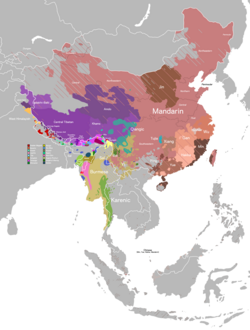Zeme language
Zeme (also called Empeo, Jeme, Kacha and Zemi[1]) is a Sino-Tibetan language spoken in northeastern India. It is one of the dialects spoken by the Zeme Naga, the other being Mzieme. Geography and demographyZeme (dialects: Paren, Njauna) is spoken in:[1] Most Zeme speakers are bi- or multi-lingual in the regional lingua franca of Manipuri and English.[2] ClassificationZeme belongs to the Kuki-Chin section of the Kamarupan group of the Baric sub-division of Tibeto-Burman language family. It is closely related to the neighboring languages of Liangmai and Rongmei.[3] PhonologyConsonants
Vowels
Zeme also has six diphthongs: /ai, ao, oi, əu, ui, əi/.[6] Like other Tibeto-Burman languages, Zeme is a tonal language. Most of the words in the language are monosyllabic in nature.[7] GrammarGender and number are not marked on Zeme verbs. The basic word order is SOV, with an alternate order of OSV, making it a verb-final language. There are 7 categories of numerals in the language: Cardinals, ordinals, fractionals, multiplicatives, distributives, restrictives, and approximates. The following are cardinal numerals:
Compound numerals are formed by adding two numerals together, with the bigger numeral, usually a multiple of 10, preceding the smaller one. The decade numerals from 40, 50, 60, 70, 80, and 90 are formed by multiplication of decade by basic numerals by 10. The numeral 'ten' in Zeme has four allomorphs: kərəiyu, he, riŋ and riyak.[9] Notes
References
|
||||||||||||||||||||||||||||||||||||||||||||||||||||||||||||||||||||||||||||||||||||||||||||||||||||||||||||||||||||||||||||||||||||||||||||||||||||||||||||||||||||||||||||||||















